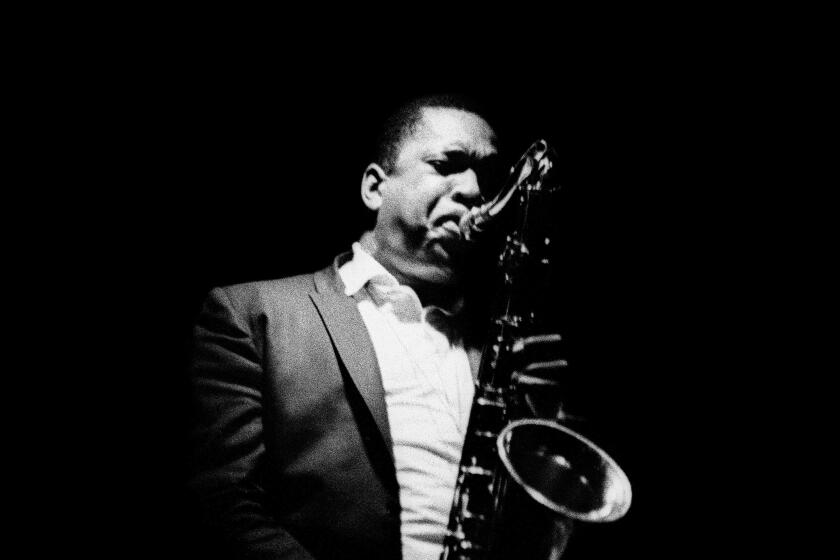Recalling Songs’ Role in Civil Rights Fight
- Share via
WASHINGTON — The Rev. Jesse Jackson once noted that while mass action--marches, sit-ins, boycotts and the like--created the body of the civil rights movement between 1955 and 1965, “the music breathed its soul.”
Yet even though the African American struggle for equality was anchored in song, that crucial element is sometimes forgotten. That should change with the Smithsonian/Folkways reissue (on two CDs) of the landmark collection “Voices of the Civil Rights Movement: Black American Freedom Songs 1960-1966.”
A social, political, cultural and musical document intertwined in one package, it was put together in 1980 by Bernice Johnson Reagon, who--before founding the world-renowned a cappella group Sweet Honey in the Rock and becoming curator (now emeritus) in African American programs at the Smithsonian and a history professor at American University--was one of the civil rights movement’s powerful voices as a member of the Student Nonviolent Coordinating Committee Freedom Singers.
Singing at mass meetings held in community churches, Reagon explains, “really helped to create the culture of action, create the ambience that could sustain a movement of struggle. On some level, you have an intellectual thing you have to do to be involved in struggle and know where you want to be, but the other part is . . . how do you feel, do you feel like doing it? The idea that you’re going to a mass meeting, and you’re going to be talking about struggle, changes if you know that that mass meeting is going to be a powerful, powerful singing experience. You’re being fed--you go to your meetings, you go to your marches, and you know that it is more than just getting your mind intellectually in line with what you believe in. You know there is going to be power because of the singing.”
That power is evident on the collection’s first disc, which focuses on material recorded in the early ‘60s at mass meetings in such segregationist strongholds as Selma, Ala.; Jackson, Greenwood and Hattiesburg, Miss.; and Danville, Va. Martin Luther King Jr. once noted that it was these mass meetings that “generated the power and depth which finally galvanized the entire Negro community.” That applied to individuals as well. As Reagon writes in the collection’s expansive booklet, it was at mass meetings that she first recognized “culture to be not luxury, not leisure, not entertainment, but the lifeblood of a community.”
According to Reagon, the majority of singing in the civil rights movement was congregational, songs sung unrehearsed in the tradition of black American choral style, but with a codified system of song leaders, call-and-response variations and the like. The movement did not create the music, Reagon adds, because “it was already part of anything black people were doing in most of those communities, where you still had a rich, accessible, community-based music. People were buying records, listening to radio, but they were also making their own music. And any time that kind of community becomes engaged in a movement, it’s going to be a strong singing movement. We see that with South Africa.”
*
Then known as Bernice Johnson, Reagon had been an activist, organizer and song leader while still an undergraduate in her hometown of Albany, Ga. Albany was also a flash point for nonviolent confrontations and the inevitable arrests, which led to her suspension from school in 1961. She moved to Atlanta and, though no longer part of the day-to-day organizing in Albany, soon found herself lending her powerful contralto to a new venture organized by James Forman, head of the Student Nonviolent Coordinating Committee, and Cordell Reagon, a student organizer and SNCC field secretary.
Knowing the importance of music to the movement, they envisioned a group that could raise the profile of activities that didn’t make for easy TV coverage, like voter registration, “a very boring, one-to-one kind of thankless effort, though also one of the most dangerous,” Reagon says. At a 1962 SNCC benefit concert in Chicago that featured well-known gospel groups as well as an ad hoc group of SNCC singers, it became clear there was a power in the singing “to communicate the movement to people who were not in the South,” she adds.
Eventually, the SNCC Freedom Singers would emerge, the first core consisting of tenors Cordell Reagon and Charles Neblett, Johnson and soprano Rutha Mae Harris. Performing in concert halls, churches, clubs, living rooms and schools around the country, they helped catalyze support and raise funds for the SNCC’s grass-roots organizing activities in the South. This group toured from December 1962 to August 1963 (including a performance during the march on Washington); there would be a number of personnel changes before the Freedom Singers disbanded in 1966.
More to Read
The biggest entertainment stories
Get our big stories about Hollywood, film, television, music, arts, culture and more right in your inbox as soon as they publish.
You may occasionally receive promotional content from the Los Angeles Times.










